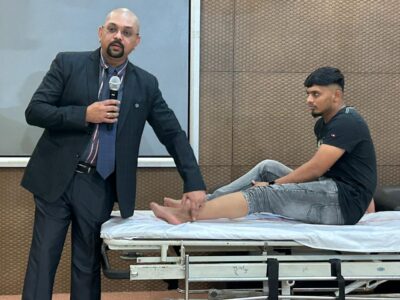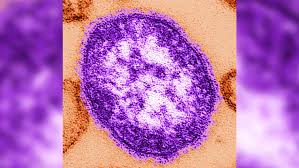Pune’s 20-Year-Old Kabaddi Player Becomes India’s First To Receive Successful Cadaveric Allograft To Repair Damaged Tendons In Ankle
The athlete suffered a chronic tear in the Peroneal Tendon, resulting in two out of three tendons being broken. The only viable solution was a Cadaveric Allograft repair, involving the transplantation of soft tissue and

The athlete suffered a chronic tear in the Peroneal Tendon, resulting in two out of three tendons being broken. The only viable solution was a Cadaveric Allograft repair, involving the transplantation of soft tissue and tendons to address the damage and enable him to resume walking and playing Kabaddi again~
In a milestone achievement, Dr Ashish Arbat, a renowned Orthopaedic and Joint Replacement Surgeon from Pune along with his team successfully performed India’s first cadaveric allograft procedure to repair the soft tissue and torn tendons in the ankle of a 20-year-old Kabaddi player. The patient had endured a Peroneal Tendon Chronic Tear, a common ankle injury resulting from sudden trauma or chronic overuse during sports activities, causing severe pain and instability in the left ankle. Following the treatment, the patient, who had been sidelined from Kabaddi due to the injury, is now on track to resume playing and pursuing his athletic goals.
Three months ago, patient Sagar Jagtap sustained a sports injury that caused excruciating pain in his left ankle even after a three-week rest period. His daily activities became challenging, necessitating help from his family members. The ongoing discomfort and instability in his ankle prevented him from returning to the game post-injury. Dr Ashish Arbat and his team revolutionized the patient’s life by performing India’s first cadaveric allograft to repair the soft tissue and tendons and mobilize him to stand back on his feet again, offering a fresh start.
Dr Ashish Arbat, Orthopaedic and Joint Replacement Surgeon, Pune said, “Upon examination, the patient showed signs of discomfort, restriction in movement, and difficulty walking. An MRI scan confirmed a complete tear in the Peroneus Bravis muscle of the left lower leg, wear and tear in the peroneus longus muscle, requiring surgical restoration treatment. Athletes inevitably face injuries as a constant reality. Peroneal tendon chronic tears are characterized by long-standing damage to the tendons, often resulting from repetitive injuries or degenerative changes. This patient’s two out of three tendons were severely damaged, making repair impossible. Although muscle transfer was considered, it posed the risk of weakening his leg and affecting his ability to walk or play sports due to loss of muscle length and bulk. Addressing chronic tears in the peroneal tendons requires meticulous surgical techniques for optimal outcomes.”
Allograft repair has emerged as a viable option, utilizing cadaver donor tissue to reconstruct the soft tissue and damaged tendons. “During surgery, the patient is positioned on the side of the stomach. An appropriately sized incision was made over the affected ankle to expose the damaged peroneal tendons and surrounding structures. The tendons were visualized and inspected for damage by removing any unhealthy tissue. This complex procedure involved the transfer of allograft tissue to repair damaged peroneal tendons. The allograft was sourced from a tissue bank for this patient and meticulously chosen based on size compatibility and structural integrity of the patient. It was then prepared through a sterilization process, ensuring it is free from contaminants and suitable for transplantation,” said Dr Arbat.
Dr Arbat added, “Debridement is a crucial step that ensures a clean and healthy environment for graft integration. The allograft was attached to the remaining healthy portions of the peroneal tendons using surgical techniques such as sutures or anchors. Graft fixation is a critical step in ensuring stability and promoting successful integration with the patient’s tissues. The uneventful surgery lasted for 30 minutes and the patient was discharged after 2 days.”
Allograft repair for peroneal tendon tears offers new hope for patients suffering from this debilitating condition. Unlike autografts, which use the patient’s own tissue, allografts eliminate the need for a secondary surgical site, reducing postoperative pain and recovery time. Allografts provide a readily available source of tissue, allowing surgeons to choose from a variety of donor tendons. This flexibility in graft selection enhances the surgical options available for addressing peroneal tendon chronic tears. The allograft can be precisely sized to match the patient’s anatomy, facilitating a tailored and accurate reconstruction. This is particularly important for achieving optimal function and minimizing the risk of complications.
After surgery, the patient was placed in a cast or brace to immobilize the ankle and facilitate the initial stages of healing. “Weight-bearing restrictions are commonly imposed to protect the repaired tendons during the critical early phases of recovery. Physical therapy also plays a pivotal role in the rehabilitation process. The gradual introduction of a range of motion exercises, strengthening protocols, and proprioceptive training helped him restore his functionality and prevent complications. Regular follow-up appointments and sonography were conducted every week to monitor the patient’s progress and detect any complications. Currently, the patient is walking, and started gymming with precautions,” said Dr Aarbat.
“Patients considering or undergoing peroneal tendon allograft repair should engage in thorough discussions with their healthcare providers to understand the intricacies of the surgery and set realistic expectations for their recovery journey and improve the quality of life. This feat signifies a step forward towards a future where organ transplants using donor tissue become more accessible and commonplace across various disciplines,” underscored Dr Arbat.
“Being the first person to undergo a tissue transplant for my ankle injury has been nothing short of miraculous. The excruciating pain that had plagued me for 3 months has finally vanished, leaving behind a newfound sense of freedom and mobility. As I take each step confidently, the feeling of uncertainty, anxiety, and fear that once gripped me has disappeared. I am grateful to Dr Arbat and his team for helping me to walk again without limping. I am on the path to recovery and healing and waiting to get back to my team and start playing,” concluded the patient Sagar Jagtap.






